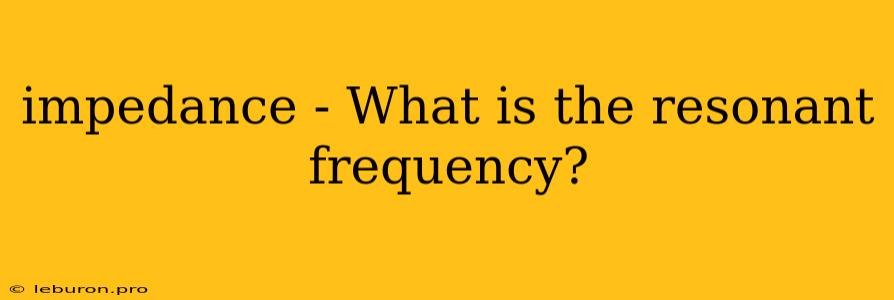Understanding Impedance and Resonant Frequency in Electrical Circuits
Impedance is a fundamental concept in electrical engineering, representing the opposition a circuit offers to the flow of alternating current (AC). It's analogous to resistance in DC circuits, but with a crucial difference: impedance considers not only the resistance but also the reactance, which arises from energy storage elements like capacitors and inductors. This dynamic interplay between resistance and reactance, especially at specific frequencies, leads to the phenomenon known as resonance.
Resonant frequency is a key concept in understanding the behavior of circuits with both capacitors and inductors. It's the frequency at which the circuit's impedance is at its minimum, meaning the circuit offers the least resistance to the flow of current. This minimum impedance can lead to a surge in current, which can be both useful and potentially harmful depending on the circuit's design.
The Nature of Impedance
Impedance, denoted by 'Z', is measured in ohms (Ω) and encompasses both resistance (R) and reactance (X). Resistance stems from the dissipation of energy in the form of heat, while reactance arises from the storage of energy in electric and magnetic fields.
Resistance
Resistance is the opposition to current flow caused by the inherent properties of the material through which the current passes. It's a constant value, independent of the frequency of the applied current.
Reactance
Reactance, on the other hand, is frequency-dependent. It comes in two forms:
-
Capacitive reactance (Xc): This arises from capacitors, which store energy in an electric field. Capacitive reactance is inversely proportional to the frequency. As the frequency increases, the capacitor charges and discharges faster, leading to a decrease in its opposition to current flow.
-
Inductive reactance (Xl): This stems from inductors, which store energy in a magnetic field. Inductive reactance is directly proportional to the frequency. As the frequency increases, the inductor's magnetic field changes faster, leading to an increase in its opposition to current flow.
The Significance of Resonant Frequency
Resonant frequency is the frequency at which the capacitive and inductive reactances in a circuit cancel each other out, resulting in the lowest impedance. This means that the circuit offers the least resistance to current flow at this particular frequency.
To understand this concept, consider a simple series RLC circuit (containing a resistor, inductor, and capacitor). The impedance of this circuit is given by:
Z = √(R² + (Xl - Xc)²)
At resonant frequency (fr), the inductive reactance (Xl) and capacitive reactance (Xc) are equal:
Xl = Xc
Therefore, the impedance becomes:
Z = R
This signifies that at resonant frequency, the impedance of the circuit is solely determined by the resistance.
Applications of Resonant Frequency
The phenomenon of resonant frequency has numerous applications in electrical engineering and other fields:
1. Radio Tuning
Resonant circuits are the heart of radio receivers, allowing them to select specific frequencies from the airwaves. When the resonant frequency of a receiver circuit matches the frequency of a radio wave, the circuit's impedance is minimized, allowing the signal to pass through.
2. Filters
Resonant circuits can be used to create filters that selectively pass or block certain frequencies. For example, a low-pass filter passes frequencies below the resonant frequency and blocks frequencies above it.
3. Oscillators
Resonant circuits are essential components of oscillators, electronic circuits that produce oscillating signals at a specific frequency. By tuning the resonant frequency of the circuit, the oscillator's output frequency can be precisely controlled.
4. Power Transmission
Resonant frequency plays a role in power transmission systems. Power lines are designed to minimize impedance at the operating frequency, ensuring efficient power transfer.
5. Medical Devices
Resonant circuits are used in medical devices like MRI scanners, where they help generate and detect specific frequencies.
Potential Challenges of Resonance
While resonant frequency is a valuable tool, it also presents potential challenges:
1. Overcurrents
At resonant frequency, the impedance of a circuit is minimized. This can lead to a surge in current, which may damage components if not properly managed.
2. Unwanted Oscillations
Resonant circuits can unintentionally oscillate if not properly dampened. This can lead to instability in circuits and systems.
3. Interference
Resonant circuits can be sensitive to interference from other frequencies. This can be a problem in applications like radio receivers, where unwanted signals can disrupt reception.
Conclusion
Impedance and resonant frequency are fundamental concepts in electrical engineering, influencing the behavior of circuits and systems. Understanding the interplay between resistance, reactance, and frequency allows engineers to design circuits that perform efficiently and reliably. By harnessing the power of resonance, we can create innovative technologies that shape our modern world.
